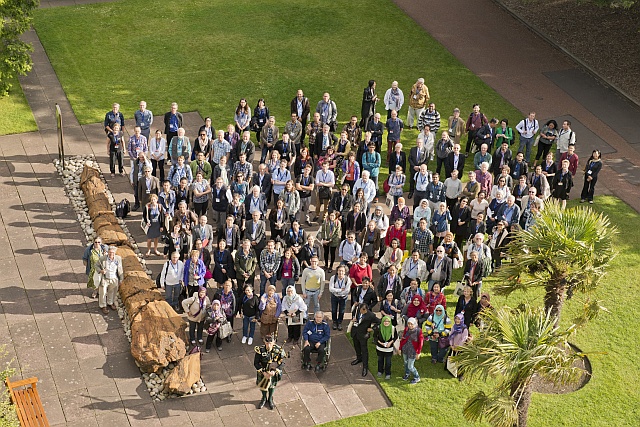 Who could resist a conference where the mascot is a giant bright red Rafflesia flower, where bagpipes serenade the participants, and kilt-wearing and traditional folk dancing are encouraged, along with stimulating science? The 10th International Flora Malesiana Symposium was hosted by the Royal Botanic Garden Edinburgh, Scotland between 11-15 July 2016. With the theme of Classify, Cultivate, Conserve (see the outstanding Spielberg-esk conference video), the meeting brought together 180 taxonomists, ecologists, biogeographers, horticulturalists, practitioners, and conservationists from 25 countries to discuss, learn, and share information about the flora of the Malesian region (Malaysia, Indonesia, Singapore, Philippines, to New Guinea). It was exciting to see progress and advances in the understanding of the biodiversity of the region since the 9th meeting in Bogor, Indonesia. One of the greatest challenges for the region is the, as yet, incomplete flora of the region due to the many constraints of publishing monographic treatments, the limitations of accessibility and funding in undertaking fieldwork to document and discover the flora of the region, and the rapid and ever increasing loss of forests. Georeferencing locaility information, and the ability to repatriate geopoint data to collections, was repeatedly highlighted as an issue for research. The importance of living collections is increasingly important for the assessment and conservation of biodiversity of the region, especially for taxonomically complex groups. With the advent of online accessibility of collections through digitization projects such as iDigBio, information about voucher specimens housed around the world are becoming increasingly available for researchers across the globe, and in particular local scientists, to study the flora of the region. Digitization of habitat and ecological information associated with voucher specimens and improved description of habitat on new collections was highlighted as a need for understanding and conserving, and providing adequate IUCN assessments of the flora.
Who could resist a conference where the mascot is a giant bright red Rafflesia flower, where bagpipes serenade the participants, and kilt-wearing and traditional folk dancing are encouraged, along with stimulating science? The 10th International Flora Malesiana Symposium was hosted by the Royal Botanic Garden Edinburgh, Scotland between 11-15 July 2016. With the theme of Classify, Cultivate, Conserve (see the outstanding Spielberg-esk conference video), the meeting brought together 180 taxonomists, ecologists, biogeographers, horticulturalists, practitioners, and conservationists from 25 countries to discuss, learn, and share information about the flora of the Malesian region (Malaysia, Indonesia, Singapore, Philippines, to New Guinea). It was exciting to see progress and advances in the understanding of the biodiversity of the region since the 9th meeting in Bogor, Indonesia. One of the greatest challenges for the region is the, as yet, incomplete flora of the region due to the many constraints of publishing monographic treatments, the limitations of accessibility and funding in undertaking fieldwork to document and discover the flora of the region, and the rapid and ever increasing loss of forests. Georeferencing locaility information, and the ability to repatriate geopoint data to collections, was repeatedly highlighted as an issue for research. The importance of living collections is increasingly important for the assessment and conservation of biodiversity of the region, especially for taxonomically complex groups. With the advent of online accessibility of collections through digitization projects such as iDigBio, information about voucher specimens housed around the world are becoming increasingly available for researchers across the globe, and in particular local scientists, to study the flora of the region. Digitization of habitat and ecological information associated with voucher specimens and improved description of habitat on new collections was highlighted as a need for understanding and conserving, and providing adequate IUCN assessments of the flora.  Further, the need for open access to data from the Malesian region was discussed and encouraged in several talks at the meeting. New publishing platforms, such as those being developed by Pensoft, the Flora Malesiana Data Portal, Flora Malesiana: Orchids of New Guinea website, and the crowd-funded Orchids of New Guinea website, along with the more traditional journals such as Edinburgh Journal of Botany and Gardens' Bulletin Singapore, are helping to streamline and expedite publication of new taxa and taxonomic treatments. The World Flora Online is also working to improve the documentation of floral biodiversity of Malesia.
Further, the need for open access to data from the Malesian region was discussed and encouraged in several talks at the meeting. New publishing platforms, such as those being developed by Pensoft, the Flora Malesiana Data Portal, Flora Malesiana: Orchids of New Guinea website, and the crowd-funded Orchids of New Guinea website, along with the more traditional journals such as Edinburgh Journal of Botany and Gardens' Bulletin Singapore, are helping to streamline and expedite publication of new taxa and taxonomic treatments. The World Flora Online is also working to improve the documentation of floral biodiversity of Malesia.

iDigBio was present at the meeting in several forms - an iDigBio display provided project information and resources to meeting participants, a poster highlighting the WeDigBio activities was presented, Shelley James moderated the e-Taxonomy session and presented on the role iDigBio can play in advancing the knowledge and botanical research in the Malesian region. The e-Taxonomy session, included talks from:
Shelley James - Integrated Digitized Biocollections (iDigBio): mobilizing natural history collections for enhanced classification and conservation of Malesian floral biodiversity;
Chuck Miller & M.Watson - Integrating digital identifiers for the World Flora Online;
Cam Webb - A Morphotype and Taxonomy Clearing House (MaTCH): hacking Malesian plant data; and
Rod Page - Open versus closed data and the challenge of creating a 21st century flora.
This session was recorded, thanks to the RGBE IT team, and should be online soon!
Regional experts visited the extensive collections housed within the RGB Edinburgh Herbarium (E), undertaking research and assisting with the much needed curation and identification of specimens from Malesia. The next meeting is proposed to take place in Borneo, and I look forward to seeing the advances that will be made in the next three years.

Even the living collections at RGBE have questions about the biodiversity of the Malesian region!
-- Contributed by Shelley A James




